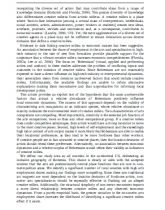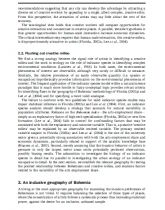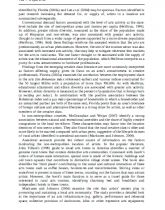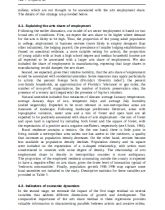Hledej
Zobraz:
Univerzity
Kategorie
Rozšířené vyhledávání
12 662
projektů
Emoting with their feet: Bohemian attraction to creative milieu
| Přípona |
Typ esej |
Stažené 0 x |
| Velikost 0,3 MB |
Jazyk anglický |
ID projektu 2861 |
| Poslední úprava 11.03.2014 |
Zobrazeno 2 031 x |
Autor: eliseus |
 Sdílej na Facebooku
Sdílej na Facebooku |
||
| Detaily projektu | ||
- Cena:
1 Kreditů - kvalita:
90,2% -
Stáhni
- Přidej na srovnání
- Univerzita:Univerzita Tomáše Bati ve Zlíně
- Fakulta:Fakulta managementu a ekonomiky
- Kategorie:Ekonomika » Management
- Předmět:Management
- Studijní obor:-
- Ročník:-
- Formát:PDF dokument (.pdf)
- Rozsah A4:26 stran
A central conjecture of the creative class theory is that creative people are attracted
to those places most conducive to creative activity. Workers in highly creative
occupations supposedly move to those places able to support rich opportunities for
social and cultural interaction. In contrast to the more venerable innovative milieu
construct that initially focused on creative interaction among workers and between
firms and research institutes to examine innovation and economic competitiveness,
members of the creative class seek to imbue creativity in all aspects of their lives.
The posited parallel between interaction that fulfills personal lives and interaction
that energizes productive lives has spawned a growing number of initiatives to
promote urban creative milieus that give rise to ‘creative cities.’
However, creative milieu remains an amorphous construct relative to the concrete
identification of actors, structures and mechanisms comprising innovative milieus.
Knowledge spillovers in a creative milieu are characterized as ‘spillacrosses’,
to those places most conducive to creative activity. Workers in highly creative
occupations supposedly move to those places able to support rich opportunities for
social and cultural interaction. In contrast to the more venerable innovative milieu
construct that initially focused on creative interaction among workers and between
firms and research institutes to examine innovation and economic competitiveness,
members of the creative class seek to imbue creativity in all aspects of their lives.
The posited parallel between interaction that fulfills personal lives and interaction
that energizes productive lives has spawned a growing number of initiatives to
promote urban creative milieus that give rise to ‘creative cities.’
However, creative milieu remains an amorphous construct relative to the concrete
identification of actors, structures and mechanisms comprising innovative milieus.
Knowledge spillovers in a creative milieu are characterized as ‘spillacrosses’,
Klíčová slova:
artist location
human-scale interaction
economic dynamism
spatial econometrics
innovation
Obsah:
- 1. Introduction
2. Beyond the tautology of creative people in creative places
3. An inclusive geography of Bohemia
4. Model specification
5. Results: explaining Bohemian location
6. Implications of Bohemian attraction to creative Milieu
References
Zdroje:
- Anselin, L. (1988) Spatial Econometrics: Methods and Models. London: Kluwer Academic Publishers.
- Anselin, L., Florax, R. J. G. M., Rey, S. (2004) Advances in Spatial Econometrics: Methodology, Tools and Applications. Berlin: Springer.
- Armington, C. and Acs, Z. J. (2002) The determinants of regional variation in new firm formation, Regional Studies, 36(1): 33-45.
- Cohen, J. P. and Paul, C. J. M. (2005) Agglomeration economies and industry location decisions: the impacts of spatial and industrial spillovers, Regional Science and Urban Economics, 35(3): 215-237.
- Davidson, R. and MacKinnon, J. G. (1993) Estimation and Inference in Econometrics. Oxford: Oxford University Press.
- Fingleton, B. (2003) Externalities, economic geography, and spatial econometrics: conceptual and modeling developments, International Regional Science Review, 26(2): 197-207.
- Florax, R. J. G. M. and de Graff, T. (2004) The performance of diagnostic tests for spatial dependence in linear regression models: a meta-analysis of simulation studies. In L. Anselin,
- R. J. G. M. Florax, S. Rey (eds) Advances in Spatial Econometrics: Methodology, Tools and Applications. Berlin: Springer, 359-80.
- Florida, R. (2002a) Bohemia and economic geography. Journal of Economic Geography, 2: 55-71.
- Florida, R. (2002b) The Rise of the Creative Class: And How it’s Transforming Work, Leisure, Community, and Everyday Life. New York: Basic Books.
- Fotheringham, A.S., Brunson, C., Charlton, M. (2002) Geographically Weighted Regression. Hoboken, New Jersey: Wiley.
- Gard, R. E. (1968) The Arts in the Small Community—A National Plan. Madison, WI: Office of Community Arts Development, University of Wisconsin-Extension.
- Glaeser, E. L., Kallal, H. D., Scheinkman, J. A., Shleifer, A. (1992) Growth in cities. Journal of Political Economy, 100(6): 1126-1152.
- Glaeser, E. L., Kolko, J., Saiz, A. (2001) Consumer city. Journal of Economic Geography, 1: 27-50.
- Hansen, H. K., Vang, J., Asheim, B. T. (2005) The creative class and regional growth: towards a knowledge based approach. Paper presented at ‘Regional Growth Agendas’ conference, Regional Studies Association, Aalborg, Denmark, May 28-31.



